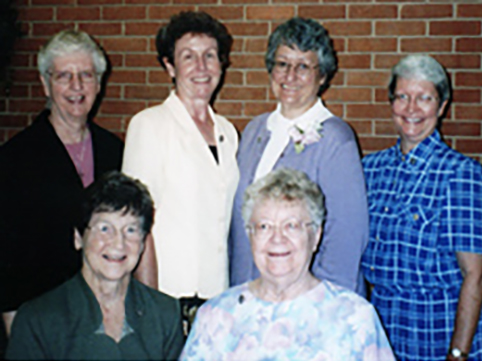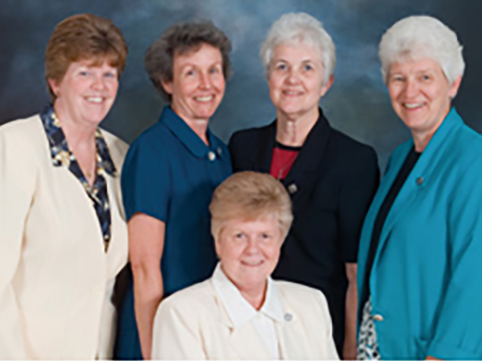Corporate DNA
The Corporate Personality of SSND
Exploring the corporate personality of SSND reminds the author of an encounter at the funeral of Sister Carol Reeb, SSND. Sitting next to a gentleman who was obviously moved by her funeral liturgy, I asked about his acquaintance with Carol. “We were on the Board of Marian Middle School together and she was a fine educator with the interest of the girls at heart. I didn’t know her well but something of her spirit touched me deeply.” Sister Carol was a beloved community member, enthusiastic educator, and a spokesperson for Mother Earth.
 Sister Carol Reeb's local SSND community.
Sister Carol Reeb's local SSND community.
Back (L to R): Sisters Doris Jean Grewe, Carol Reeb, Glenda Becker, Judy Ann Obermark.
Front (L to R): Sisters Frances Ann Eveler and Catherine DeWitt.
 Sister Carol Reeb's Provincial Council leadership team.
Sister Carol Reeb's Provincial Council leadership team.
Back (L to R): Sisters Kathy Schmittgens, Carol Reeb, Pat Delaney, Celine Schumacher.
Seated: Sister Joanne Hanrahan.
Often a meeting with one School Sister of Notre Dame has led others to identify a certain set of values that are found in the SSND-DNA: an identity or corporate personality does emerge. This segment will focus on a few stories that exemplify some of the traits of character found in this corporate DNA.
The following stories illustrate values of School Sisters of Notre Dame that have been noted through 175 years of history and creating community. When SSNDs are at their best these characteristics come to the fore in their decision-making, community living and ministry. Further development is found throughout Sturdy Roots.
Internationality
After World War II School Sisters of Notre Dame in North America sent Care Packages to European SSNDs, providing items that had become scarce in a post-war economy. However, our European sisters also gave gifts. In reviewing the chronicle entries there are two striking gifts that are mentioned.
- The Munich Province sent the St. Louis Province a gift in gratitude for their help after World War II. It was a lovely violin that continues to be played on special occasions and has been passed from violin teacher to SSND students over the past 50 years. (More on this story is available in Sturdy Roots, “Living in Wartime,” “Care Packages.)
- A second story is told by our German sisters of Fussen who fed American prisoners of war during World War II. In gratitude for their generosity, the American servicemen sent the sisters woolen cloth, toothbrushes, flour, etc. after their release and return to the States. (Ibid.)
Eucharistic Living
The Nun Study is an example of Eucharistic Living as 678 School Sisters of Notre Dame have given their time and energy in yearly evaluations documenting their own diminishment to help in Alzheimer’s research. Brain donation is also a significant part of their gift.
- CNN created a documentary showing the School Sisters of Notre Dame of Mankato going through the yearly evaluations, conversing about aging, etc. The uniqueness of this presentation is that it is set in the context of Eucharist. (This is found in Sturdy Roots, “The Nun Study,” View CNN.
- In “Living in Wartime,” there is a letter written by Mother Almeda Schricker, SSND, describing the bombing of the Munich Motherhouse during World War II. The entire letter is written in the context of the liturgy of Gaudete Sunday and the hope conveyed in the midst of total devastation. This is found in Sturdy Roots, “Living in Wartime,” Bombing of the Munich Motherhouse.
Poverty
Sisters living in Berlin, Germany, were divided by the Berlin Wall. The sisters living in East Berlin were allowed to care for babies born out of wedlock, until the age of 2, and then they were taken from the sisters to be placed in foster homes. They could also care for mentally challenged adults. All other ministries were forbidden to them. In 1989, years after the war, the Polish SSNDs sent a hand carved statue of Mother Theresa Gerhardinger to their sisters in East Berlin and one also to West Berlin.
Read the story of the difficulties the German sisters in East Berlin had in receiving the statue from their Polish sisters. (This can be found in Sturdy Roots, under “Communism,” Statue of Mother Theresa.)
Ministry to Immigrants
One of the constant aspects of SSND ministry has been service to immigrants. From the beginning Mother Theresa and Mother Caroline were both conscious of serving German immigrants primarily through education.
- Read their letters on first-impressions of American Children found in Sturdy Roots, “Education,” American Children.
- Look at Sturdy Roots, “Expansion,” Immigrants, and choose one story related by SSNDs currently working with immigrants in the U.S. and South America.
Fostering Systemic Change and Reconciliation
Mother Theresa was one of the first women in church history to lead a women’s congregation with no male director over her. This desire to live Jesus’ mission in developing the gifts of women prompted a lifetime of dedication to education.
- Read one letter that Mother Theresa and her council wrote to Pope Pius IX asking for his consideration of this “new” way to govern women religious.
- Consider her role of reconciliation with the hierarchical church throughout her turmoil in attempting to dialogue. This can be found in Sturdy Roots, “Being Church.”
Love of Earth and Respect for Creation
Consider the life of Dorothy Olinger, SSND, and her education on the Universe Story as related in Sturdy Roots, “Voices of Change.” In her essay she describes herself as very conservative and doing only what would be approved by authority. A precious moment is related in her biography that changed her life and ministry.
- Read her essay and note how eating an apple opened her to a new paradigm, a cosmic consciousness that energized her educational ministry.
- The importance of Earth and all creation is part of the mandate for the congregation in the next five years. Share the mandate as found in Sturdy Roots, “Creative Fidelity,” Chapter Themes, 22nd General Chapter. This lets others know the international priorities for School Sisters of Notre Dame.
Love for the Poor, Youth, and Women
The School Sisters of Notre Dame have expanded to various cultures throughout the past 175 years. In Sturdy Roots, “Expansion,” examples of missionary activity exemplifies this theme, both in establishing education for women and surviving the crises of evacuation due to political turmoil.
- Read through the various accounts of deciding to send sisters to Africa, Asia, Central and Latin America and see this basic theme as our motivation.
- The sisters’ story of going to Liberia carries these desires and also the sadness of needing to evacuate and leaving those they loved.
Desire for Justice
School Sisters of Notre Dame in various cultures would have examples of taking action for justice. As an international congregation we have chosen to be part of the United Nations as a Non-Governmental Organization.
- Consider the advocacy for Women and girl-children by reading through the ministry of Ann Scholz, SSND and “SSND at the UN.”
- The role of the SHALOM Network is another example of educating for justice through SHALOM Clubs.
- Another aspect of justice and peace-making may be found in “Voices of Change,” especially in the life story of Margaret Ellen Traxler, SSND and others listed with her.
Education
The role of education is basic to understanding the corporate personality of the School Sisters of Notre Dame. From Mother Theresa’s views on education to examples that go beyond formal classroom education, SSNDs continue to share the Mission of Jesus as educators.
- Read the two classic letters of Mother Theresa and Mother Caroline on American children found in Sturdy Roots under “Education.”
- Reflect on the experience of Kathleen Spencer, SSND, in her role as educator with the immigrant community in St. Paul, MN under Expansion, “Immigrants.”